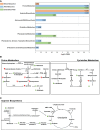Impact of preovulatory follicle maturity on oocyte metabolism and embryo development
- PMID: 38752021
- PMCID: PMC11095542
- DOI: 10.1093/pnasnexus/pgae181
Impact of preovulatory follicle maturity on oocyte metabolism and embryo development
Abstract
Improved oocyte competence for embryo development and pregnancy was observed following ovulation of preovulatory follicles with greater physiological maturity, as indicated by estradiol production, prior to the gonadotropin-releasing hormone (GnRH)-induced luteinizing hormone (LH) surge. It was hypothesized that follicular fluid from preovulatory follicles of greater maturity better supports the maturing oocyte's metabolic requirements and improves embryo development. The objective was to determine if differences in preovulatory follicular fluid due to follicle maturity influence oocyte metabolism during in vitro maturation (IVM) and affect embryo development. Bovine preovulatory follicular fluid was collected 18 h after a GnRH-induced LH surge. Serum estradiol concentration at GnRH administration categorized follicles as greater or lesser maturity. Immature bovine oocytes were submitted to 24 h IVM in medium supplemented with 20% follicular fluid from preovulatory follicles of greater or lesser maturity. Embryo development was recorded. Oocyte maturation media and media conditioned by developing embryos were submitted for metabolomics. A randomized block design was utilized to determine differences in embryo development and media metabolites (P ≤ 0.05). Blastocysts from oocytes matured in greater vs. lesser maturity follicular fluid had a more moderate rate of development (P = 0.01). At the conclusion of 24 h IVM, abundance of 66 metabolites differed between greater and lesser follicle maturity treatments. Nine metabolites differed in media conditioned by developing embryos. Metabolome results suggest improved amino acid, purine, and glucose metabolism, followed by a more efficient rate of embryo development, in oocytes matured in greater vs lesser maturity follicular fluid.
Keywords: bovine; cumulus-oocyte complex metabolism; embryo development; follicular fluid; preovulatory follicle.
© The Author(s) 2024. Published by Oxford University Press on behalf of National Academy of Sciences.
Figures



References
LinkOut - more resources
Full Text Sources
Other Literature Sources

